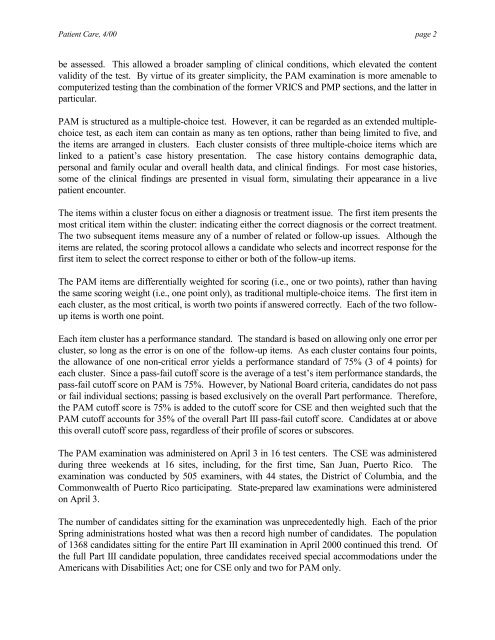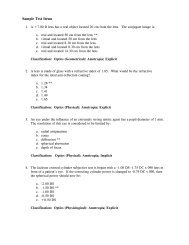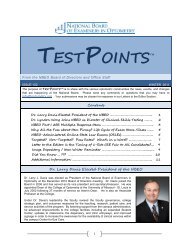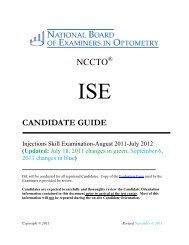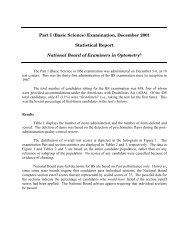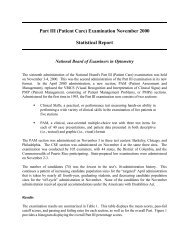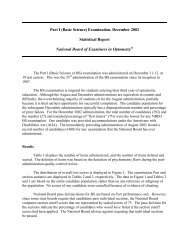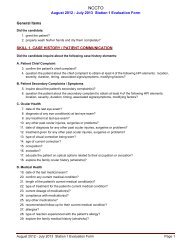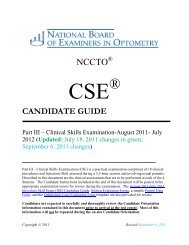Part III - National Board of Examiners in Optometry
Part III - National Board of Examiners in Optometry
Part III - National Board of Examiners in Optometry
You also want an ePaper? Increase the reach of your titles
YUMPU automatically turns print PDFs into web optimized ePapers that Google loves.
Patient Care, 4/00 page 2be assessed. This allowed a broader sampl<strong>in</strong>g <strong>of</strong> cl<strong>in</strong>ical conditions, which elevated the contentvalidity <strong>of</strong> the test. By virtue <strong>of</strong> its greater simplicity, the PAM exam<strong>in</strong>ation is more amenable tocomputerized test<strong>in</strong>g than the comb<strong>in</strong>ation <strong>of</strong> the former VRICS and PMP sections, and the latter <strong>in</strong>particular.PAM is structured as a multiple-choice test. However, it can be regarded as an extended multiplechoicetest, as each item can conta<strong>in</strong> as many as ten options, rather than be<strong>in</strong>g limited to five, andthe items are arranged <strong>in</strong> clusters. Each cluster consists <strong>of</strong> three multiple-choice items which arel<strong>in</strong>ked to a patient’s case history presentation. The case history conta<strong>in</strong>s demographic data,personal and family ocular and overall health data, and cl<strong>in</strong>ical f<strong>in</strong>d<strong>in</strong>gs. For most case histories,some <strong>of</strong> the cl<strong>in</strong>ical f<strong>in</strong>d<strong>in</strong>gs are presented <strong>in</strong> visual form, simulat<strong>in</strong>g their appearance <strong>in</strong> a livepatient encounter.The items with<strong>in</strong> a cluster focus on either a diagnosis or treatment issue. The first item presents themost critical item with<strong>in</strong> the cluster: <strong>in</strong>dicat<strong>in</strong>g either the correct diagnosis or the correct treatment.The two subsequent items measure any <strong>of</strong> a number <strong>of</strong> related or follow-up issues. Although theitems are related, the scor<strong>in</strong>g protocol allows a candidate who selects and <strong>in</strong>correct response for thefirst item to select the correct response to either or both <strong>of</strong> the follow-up items.The PAM items are differentially weighted for scor<strong>in</strong>g (i.e., one or two po<strong>in</strong>ts), rather than hav<strong>in</strong>gthe same scor<strong>in</strong>g weight (i.e., one po<strong>in</strong>t only), as traditional multiple-choice items. The first item <strong>in</strong>each cluster, as the most critical, is worth two po<strong>in</strong>ts if answered correctly. Each <strong>of</strong> the two followupitems is worth one po<strong>in</strong>t.Each item cluster has a performance standard. The standard is based on allow<strong>in</strong>g only one error percluster, so long as the error is on one <strong>of</strong> the follow-up items. As each cluster conta<strong>in</strong>s four po<strong>in</strong>ts,the allowance <strong>of</strong> one non-critical error yields a performance standard <strong>of</strong> 75% (3 <strong>of</strong> 4 po<strong>in</strong>ts) foreach cluster. S<strong>in</strong>ce a pass-fail cut<strong>of</strong>f score is the average <strong>of</strong> a test’s item performance standards, thepass-fail cut<strong>of</strong>f score on PAM is 75%. However, by <strong>National</strong> <strong>Board</strong> criteria, candidates do not passor fail <strong>in</strong>dividual sections; pass<strong>in</strong>g is based exclusively on the overall <strong>Part</strong> performance. Therefore,the PAM cut<strong>of</strong>f score is 75% is added to the cut<strong>of</strong>f score for CSE and then weighted such that thePAM cut<strong>of</strong>f accounts for 35% <strong>of</strong> the overall <strong>Part</strong> <strong>III</strong> pass-fail cut<strong>of</strong>f score. Candidates at or abovethis overall cut<strong>of</strong>f score pass, regardless <strong>of</strong> their pr<strong>of</strong>ile <strong>of</strong> scores or subscores.The PAM exam<strong>in</strong>ation was adm<strong>in</strong>istered on April 3 <strong>in</strong> 16 test centers. The CSE was adm<strong>in</strong>istereddur<strong>in</strong>g three weekends at 16 sites, <strong>in</strong>clud<strong>in</strong>g, for the first time, San Juan, Puerto Rico. Theexam<strong>in</strong>ation was conducted by 505 exam<strong>in</strong>ers, with 44 states, the District <strong>of</strong> Columbia, and theCommonwealth <strong>of</strong> Puerto Rico participat<strong>in</strong>g. State-prepared law exam<strong>in</strong>ations were adm<strong>in</strong>isteredon April 3.The number <strong>of</strong> candidates sitt<strong>in</strong>g for the exam<strong>in</strong>ation was unprecedentedly high. Each <strong>of</strong> the priorSpr<strong>in</strong>g adm<strong>in</strong>istrations hosted what was then a record high number <strong>of</strong> candidates. The population<strong>of</strong> 1368 candidates sitt<strong>in</strong>g for the entire <strong>Part</strong> <strong>III</strong> exam<strong>in</strong>ation <strong>in</strong> April 2000 cont<strong>in</strong>ued this trend. Ofthe full <strong>Part</strong> <strong>III</strong> candidate population, three candidates received special accommodations under theAmericans with Disabilities Act; one for CSE only and two for PAM only.


